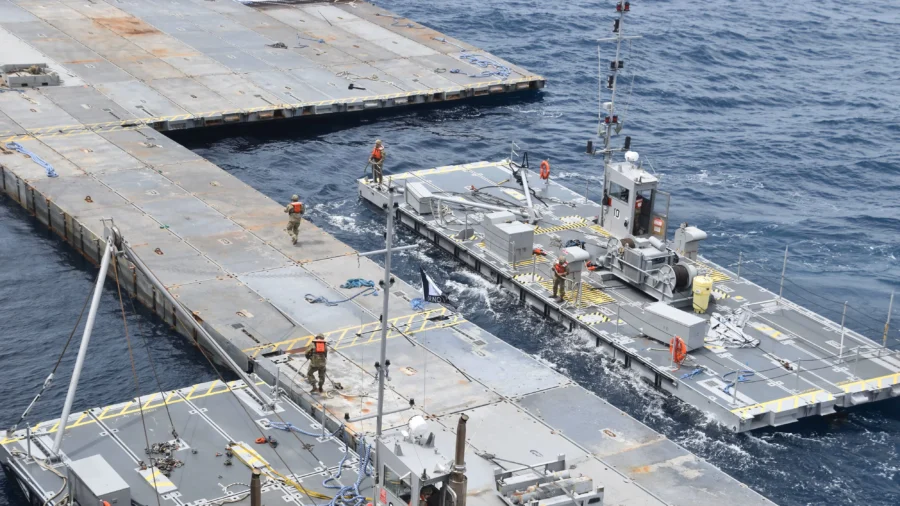The U.S. military has announced that U.S. forces have finished installing a makeshift pier for delivering humanitarian supplies into the Gaza Strip, and aid has begun to flow into the territory.
President Joe Biden initially ordered the U.S. military to construct the pier in March, to facilitate increased deliveries of food and humanitarian supplies by sea. Speaking at a press briefing on Thursday, Deputy Pentagon Press Secretary Sabrina Singh announced U.S. military engineers, working with Israeli military counterparts, had successfully anchored the temporary pier system to the beach in Gaza.
Ms. Singh said the pier was successfully installed without the need of U.S. boots on the ground in the embattled territory. She told reporters at the Thursday press briefing that the aid would begin to flow through the pier system “as soon as the Commander feels that we are ready to go.”
Hours after the Pentagon press briefing, the U.S. Central Command (CENTCOM) announced in a press statement that “trucks carrying humanitarian assistance began moving ashore” through the pier system at around 9 a.m. local time on Friday morning.
“This is an ongoing, multinational effort to deliver additional aid to Palestinian civilians in Gaza via a maritime corridor that is entirely humanitarian in nature, and will involve aid commodities donated by a number of countries and humanitarian organizations,” CENTCOM added.
In an April 25 press call, U.S. military officials estimated the temporary humanitarian aid pier would reach initial operational capacity sometime in “early May.” The effort to build and install the pier was delayed last week over reports of poor weather.
Ms. Singh said last month that it would initially cost $320 million to begin operating the temporary pier. Costs could continue to rise as the U.S. military and U.S. and international partners continue to operate the makeshift humanitarian delivery route.
At a White House press briefing on Friday, National Security Council spokesman John Kirby said there’s “a small footprint” of U.S. troops stationed on the pier who will not step foot onto shore as part of the operation. Mr. Kirby declined to provide a specific number of troops who will comprise this U.S. military presence on the pier, but said they are there to “provide a modicum of security” for the humanitarian operation and to assist in the logistical operations as cargo ships approach the pier and let off trucks to flow across a makeshift causeway onto the Gazan shoreline.
Mr. Kirby said another contingent of U.S. Navy personnel operating “well off the coast” are also involved in the pier operation.
US Expanding Humanitarian Delivery Capacity Amid Famine Concerns
Completion of this humanitarian aid pier comes more than seven months into the ongoing Israel-Hamas conflict in the Gaza Strip, with the Israeli government bent on eliminating the designated terrorist group and freeing hostages taken by Hamas gunmen and other terrorists on Oct. 7, 2023.
The ongoing conflict has disrupted access to food, water, and other humanitarian supplies, and degraded civilian infrastructure throughout the territory. U.S. Agency for International Development (USAID) Administrator Samantha Power testified at an April 10 House hearing that nearly the entire population of the Gaza Strip “is living under the threat of famine” and that famine conditions have likely already begun in some areas of the Gaza Strip.
At this April 10 hearing, Ms. Power said around 500 commercial and humanitarian trucks would enter the Gaza Strip on a daily basis prior to Oct. 7. The flow of supply trucks fell after the start of the conflict. Ms. Power said the number of these supply trucks reaching the Gaza Strip has recovered somewhat but that “we need to go way beyond that” to meet the humanitarian needs in the territory.
“The destruction of greeneries, and markets, and arable land, and then the fact that so few trucks got in over so many months means we have massive catch-up to do,” Ms. Power added during her April 10 testimony.
The United Nations Relief and Works Agency for Palestine Refugees (UNRWA) has reported some 5,671 aid trucks entered the Gaza Strip in the month of April, for a daily average of 189 trucks. UNRWA estimates another 1,296 trucks arrived in the Gaza Strip between May 1 and May 15; a daily average of about 89 trucks.
The Pentagon assesses the new humanitarian aid pier can facilitate another 90 truckloads of humanitarian aid each day at its initial operating capacity. Once fully operational, the Pentagon says that number should jump to about 150 truckloads, or roughly 2,000,000 meals per day.
The U.S. military has facilitated some additional aid deliveries with airdropped packages.
“The amount of trucks coming off of the pier is not going to be the same of what can come from the land crossings,” Ms. Singh said Thursday. “So, we have to see those land routes open. And the quickest way to get aid in, whether it be the north or anywhere else in Gaza, is going to be through those land routes. This is just meant to be an additive measure.”

